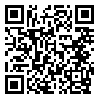BibTeX | RIS | EndNote | Medlars | ProCite | Reference Manager | RefWorks
Send citation to:
URL: http://jdisabilstud.org/article-1-1691-fa.html
2- استادیار، گروه روانشناسی، واحد ساری، دانشگاه آزاد اسلامی، ساری، ایران
چکیده
زمینه و هدف: رفتارهای پرخطر به رفتارهایی اطلاق میشود که احتمال نتایج مخرب جسمی، روانشناختی و اجتماعی را برای فرد افزایش میدهد. هدف پژوهش حاضر، بررسی اثربخشی آموزش مبتنی بر پذیرش و تعهد، بر کیفیت روابط خانوادگی و احساس ناکامی نوجوانان دختر دارای رفتارهای پرخطر بود.
روشبررسی: روش پژوهش حاضر نیمهآزمایشی بود که بهصورت طرح پیشآزمون و پسآزمون با گروه گواه اجرا شد. جامعهٔ آماری پژوهش حاضر، شامل تمامی نوجوانان دختر متوسطهٔ دوم شهرستان بابلسر، در سال تحصیلی ۹۷-۱۳۹۶ بود. نمونهٔ پژوهش شامل ۳۶ نوجوان دختر (۱۸ نفر گروه آزمایش و ۱۸ نفر گروه گواه) بودند که بهصورت نمونهگیری هدفمند از میان کسانی انتخاب شدند که واجد شرایط بوده و بهصورت تصادفی در دو گروه آزمایشی (۱۸نفر) و گواه (۱۸نفر) تخصیص یافتند. برای جمعآوری دادهها از پرسشنامهٔ رفتارهای پرخطر نوجوانان ایرانی زادهمحمدی و احمدآبادی (۱۳۸۷)، پرسشنامهٔ کیفیت روابط خانوادگی (ناتان بیاپشتاین و همکاران، ۱۹۸۳) و پرسشنامهٔ احساس ناکامی (گیلبرت و آلن، ۱۹۹۸) استفاده شد. گروه آزمایش، طی هشت جلسه (هفتهای دوجلسه ۴۵ دقیقهای)، بهصورت گروهی تحت آموزش پذیرش و تعهد قرار گرفتند. دادههای جمعآوریشده، با استفاده از نرمافزار SPSS نسخهٔ ۲۵ و روش تحلیل کوواریانس تحلیل شدند و سطح معناداری، ۰٫۰۵ در نظر گرفته شد.
یافتهها: نتایج تحلیل کواریانس نشان داد که اثربخشی آموزش مبتنی بر پذیرش و تعهد با کاهش احساس ناکامی (۰٫۰۰۱>p) و افزایش کیفیت روابط خانوادگی نوجوانان دختر دارای رفتارهای پرخطر(۰٫۰۰۱>p) همراه بود.
نتیجهگیری: براساس یافتههای این پژوهش میتوان نتیجه گرفت، آموزش پذیرش و تعهد اثربخشی بوده و سبب افزایش کیفیت روابط خانوادگی و کاهش احساس ناکامی نوجوانان دارای رفتارهای پرخطر شده است.
| بازنشر اطلاعات | |
 |
این مقاله تحت شرایط Creative Commons Attribution-NonCommercial 4.0 International License قابل بازنشر است. |






